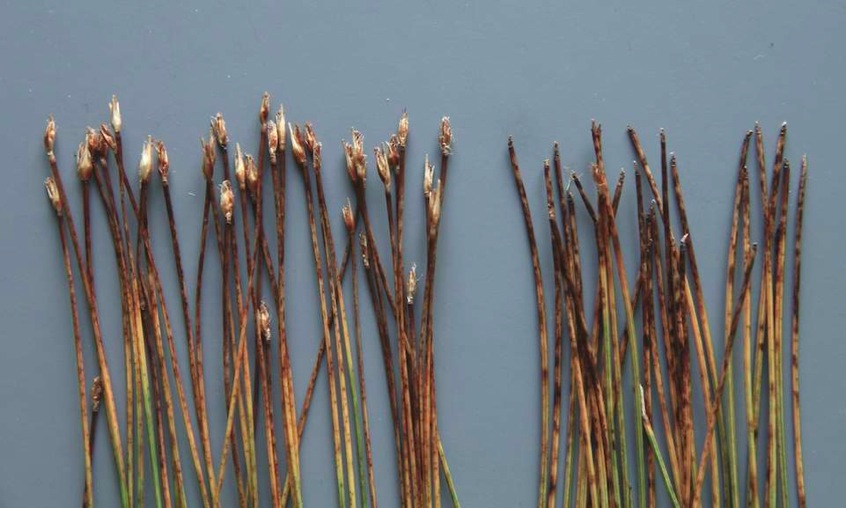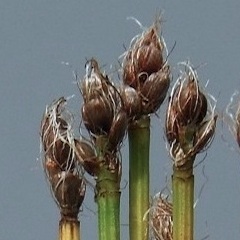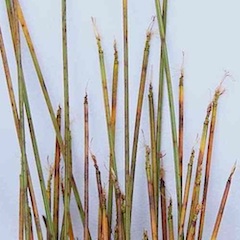Trichophorum
Deergrasses
Field identification ~ 1: Key
Although externally similar, the two deergrass species diverge strongly in their internal structures, and are readily separable: these are two good species!
Frustratingly, the morphology of the widespread hybrid bridges the distance between the two.
Remember that from July onwards the hybrid has ‘bare stem-tops’ because it never ripens nuts and its glumes are shed.
The two species ripen nuts (but only in favourable seasons), and these become more obvious as the season progresses and the glumes are shed (check section C ⇒below for separation of infertile plants from hybrids and of the species).
(The two species can be confirmed with a high degree of confidence by examination of their ⇒Stem cross-sections. The hybrid is often obvious enough from a stem cross-section, although there are examples which approach the parents. It is possible that these may be backcrosses.)
You can download a two-sided field-ID chart here ⇓PDF (114 KB).
The following is for plants at the height of the deergrass season – July/August.
➤➤ nuts present? or no nuts...?
EITHER ... OR
A: RIPE plants (i.e. the two species) in the field
See also ⇒Field ID ~ 2 (nuts and sheaths)
Common Deergrass T. germanicum
• tussocks often robust, tall, very dense ‘like shaving-brush’ (but can be diffuse and dwarfed and more resemble cespitosum)
• stems thicker – typically 1 mm wide (but thinner when starved); rarely flexuous
• spikes fuller, usually with more nuts (4 or many more)
• ripe nuts brown, with a variable grey bloom (which can erode)
• topmost leaf-sheath opening strongly oblique, and therefore long (longer axis 2 mm or more); never looking circular
• in acidic peat communities of various kinds; from seeping faces of cliffs to well-drained peaty heath soils; avoids calcareous situations
• proliferous plants quite frequent.
Northern Deergrass T. cespitosum s.s.
• tussocks less tall and less dense, sometimes diffuse with scattered stems – and then can be inconspicuous
• stems thinner – often ca. 0.5–0.6 mm wide; often flexuous, ‘wispy’
• spikes very small with few nuts: often with only 1–3(–4) when ripe
• ripe nuts dark brown (look blackish!) and usually shiny from the start
• topmost leaf-sheath opening transverse to somewhat oblique, and longer axis ca. 1 mm (can look almost circular)
• either in runnels and sphagnum lawns on deep peat mires; also (and much more distinctively) in calcareous springs and flushes
• never (?) proliferous (please collect candidates).
B: STERILE plants - likely to be the hybrid
(But check next Section C)
(The ⇒stem cross-section may have to be used in doubtful cases!)
Hybrid Deergrass T. × foersteri
The hybrid never[**] ripens nuts! In the period July to late August, when plants of either species should be carrying some ripening or ripe fruits, populations of the hybrid are obvious in having ‘bare tops’, the aborted fruits and glumes having been shed.
• tussocks vary strikingly in size and vigour, depending upon habitat: they can be robust, tall, dense when with T. germanicum; can be small and weak in calcareous habitats with T. cespitosum.
• stem width varying between the species' sizes
• heads soon abort and drop nuts and glumes (during July)
• nuts never ripen, and are shed early and unripe – ovaries whitish or greenish and never filled out, although can elongate before being shed early
• topmost leaf-sheath opening oblique, between the parents, longer axis often 1.4–1.6 mm
• in acidic peat communities of various kinds, as the germanicum parent, but also can accompany the cespitosum parent in calcareous communities
• often greatly outnumbering either parent
• proliferous plants quite frequent.
Now see ⇒Field ID ~ 2 (nuts and sheaths)
[** Please collect and submit stems of apparent hybrid with ripe nuts!]
Usually the spikes then retain the glumes (below left), which become bleached and pale.
This is unlike the hybrid (below right) where glumes begin to drop by early July, and heads then become completely bare except for a few retained bristles and filaments. [Please check how well this distinction holds up, and let me know!]

sterile heads of T. germanicum (left) and ‘bare tops’ of T. × foersteri (right)
from the same site, Dalehead Tarn, Cumbria, in late August
If a case of ‘aborted species’ is suspected, then closer examination is needed. The sheath-opening angle may give hints (but the sheath begins to split through August).
(It may be necessary to resort to examination of ⇒Stem cross-sections in ambiguous cases.)
Links to other pages
Summary pages
Identification pages
Other information


